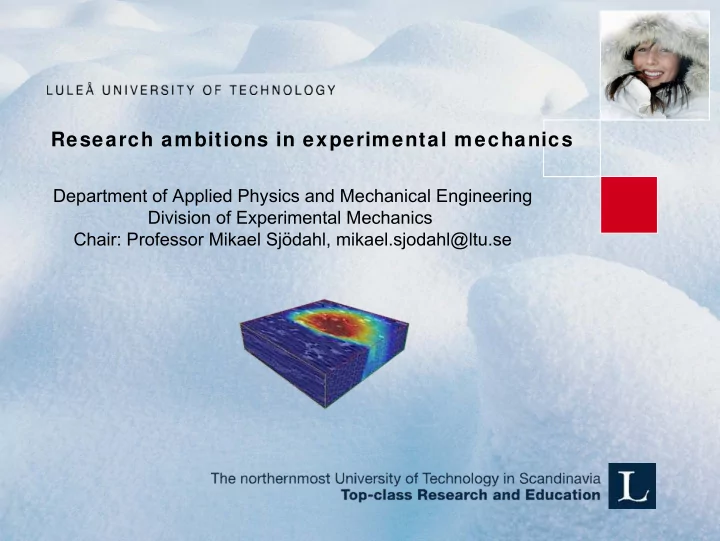

Research ambitions in experimental mechanics Department of Applied Physics and Mechanical Engineering Division of Experimental Mechanics Chair: Professor Mikael Sjödahl, mikael.sjodahl@ltu.se
Research areas Applications Physically based estimation Other methods Robust field information extraction 3D and 4D metrology
Research area: 3D and 4D metrology Research challenge: how to fill the • Phase objects (k, ω ) space to reach a sufficient • Particles • Multiple scattering objects resolution and reliability in (x,t) • Surfaces space without being prone to environmental disturbances
Phase objects (1) Challenges: mapping ( ) ( ) ( ) ω = ω + ω ˆ n , n , ik , x x x Tools: • Digital holography Quantitative laser ablation, 835 ns after interaction • Projection tomography • Deflectometry Contact Per Gren and Eynas Amer for more information
Particles (2) Laser Challenges: • position • size • (motion) • (interaction) • … Particle distance > Airy spot size Tool: Digital holography
Multiple scattering objects / imaging w ithin opaque objects (3) Tools: • Digital holography/tomography • OCT • Multiphysical imaging: • Optical-acoustical-optical • Optical-heat-optical Contact Erik Olsson for more information
Surfaces / 2.5D (4) Challenges: • Rapidly, typically one frozen image • High spatial resolution Methods: • Projected fringes • Projected speckles • Interferometry • Wave-front sensor • Phase-coding Contact Sara Rosendahl and Emil Hällstig for more information
Research area: Robust field information extraction • Field approach; i. e. FEM • Noise immune • Amplitude • Phase • Deformation • Polarization Research challenge: set up a general framework in which distributed optical complex signals may be analysed in a robust way without deteriorating the resolution in the signals acquired
”FEM” – approach 1, 2 , 3 D • Correlation optimization • Continuous within each element • Continuous between elements • Remeshing • Enrichment functions for discontinuities
Example 1D deformation Piecewise Chebyshev polynomials, marked interval centres Estimated piecewise Chebyshev polynomials, marked interval centres 2 2 1.5 1.5 1 1 Displacement [pixels] Displacement [pixels] 0.5 0.5 0 0 -0.5 -0.5 -1 -1 -1.5 -1.5 -2 -2 0 200 400 600 800 1000 1200 0 200 400 600 800 1000 1200 Position [pixels] Position [pixels] Estimated piecewise Chebyshev polynomials, marked interval centres Global optimization Estimated piecewise Chebyshev polynomials, marked interval centres 2 2 2 1.5 1.5 1.5 1 1 1 Displacement [pixels] Displacement [pixels] 0.5 Displacement [pixels] 0.5 0.5 0 0 0 -0.5 -0.5 -0.5 -1 -1 -1 -1.5 -1.5 -1.5 -2 -2 0 200 400 600 800 1000 1200 -2 0 200 400 600 800 1000 1200 0 200 400 600 800 1000 1200 Position [pixels] Position [pixels] Position [pixels]
Separating medium and information Measured phase Plate variation Noise = + ≈ Digital filter Contact Henrik Lycksam for more information!!!! Reference noise
Research area: Physically based estimation Research challenge: How to combine observables with verified physical relations to obtain new information Tools: • Highly resolved measurements • Physical model • Optimization/fitting
Example: Laser ablation – point explosion model • Released energy • Density, pressure, temperature • Electron density • Recombination rate • Conversion efficiency Contact Per Gren and Eynas Amer for more information
Example: Friction estimation The plot to the left shows a comparison between estimated road friction based on a forward looking optical sensor and measured friction. Contact Johan Casselgren for more information
Automatic comparison betw een CAD model and measurement • Applied mathematics, LTU • ”Iterative closest point” • Focus on speed, ~1 sec • Measurands: edges, holes, surface defects, angles, … Contact Sara Rosendahl for more information
Recommend
More recommend